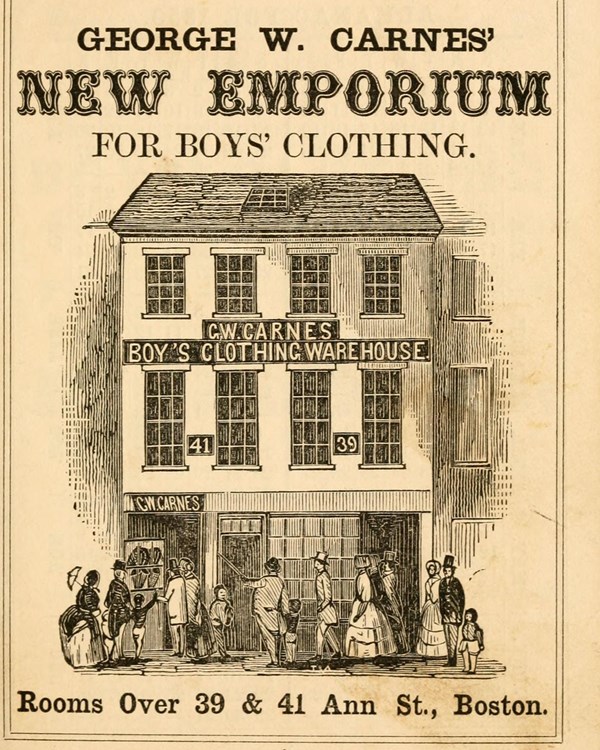Last updated: October 12, 2023
Person
George Carnes

Winterthur Museum Library, Internet Archive
Boston clothing dealer George W. Carnes served in the 1850 Boston Vigilance Committee.
Born in Boston in 1821, George W. Carnes ran a clothing store at 41 Ann Street in the city.1 His store specialized in high-end boy's clothing. In 1851, he married Caroline D. Loring of Boston. The couple had two children.2
The passage of the Fugitive Slave Law in 1850 compelled Carnes to action. He wrote a letter to the editor of the Traveller, later republished in the Liberator, in response to recent comments by abolitionist Timothy Gilbert, soon-to-be president of the Boston Vigilance Committee. Carnes praised Gilbert for invoking "Divine Law over that which is human" and refusing to abide by the Fugitive Slave Law despite the risks of doing so. Carnes stated that, like Gilbert, he would be:
ready at all times to co-operate in making an asylum for the fugitive slaves, even though bonds and imprisonment should prove the penalty.3
Carnes soon joined the newly formed Boston Vigilance Committee. Records indicate that he donated money several times to the organization.4
Following abolitionist John Brown's unsuccessful raid on Harper's Ferry, Virginia, and subsequent execution for treason in 1859, Carnes once again felt called to action. Moved by Brown's "soul stirring language" as he addressed the Virginia Court, Carnes had 1000 copies of this speech printed to sell with proceeds going to support Brown's family.5
Carnes died in Brookline, Massachusetts on February 7, 1892. He is buried in Mt. Auburn Cemetery in Cambridge, Massachusetts.6
Footnotes
- NPS maps geolocates the shop at the approximate location of Ann Street, which is North Street in the North End today. George Adams, The Boston Directory from July 1850 to July 1851 (Boston: George Adams, 1850), 110, https://cdm.bostonathenaeum.org/digital/collection/p16057coll32/id/42/rec/3; George W. Carnes’ New Emporium For Boys’ Clothing, Pamphlet, 1850, Winterthur Museum Library, https://archive.org/details/catalog00geor/page/n1/mode/2up
- Find a Grave, database and images (https://www.findagrave.com/memorial/161559678/george-w-carnes: accessed 23 July 2023), memorial page for George W. Carnes (1821-7 February 1892), Find a Grave Memorial ID ID 161559678, citing Mount Auburn Cemetery, Cambridge, Middlesex County, Massachusetts, USA, Maintained by Mayflower Pilgrim 332 (contributor 47081711); "United States Census, 1850" Database with images. FamilySearch (https://familysearch.org/ark:/61903/3:1:S3HT-DZ6P-R4?view=index&personArk=%2Fark%3A%2F61903%2F1%3A1%3AMDSC-KVZ&action=view&groupId=TH-266-11113-20778-28: accessed 17 August 2023, Massachusetts > Norfolk > Boston > images 20 and 21 of 654; citing NARA microfilm publication M432 (Washington, D.C.: National Archives and Records Administration, n.d.).
- "The Fugitive Slave Bill," republished in the Liberator, October 4, 1850, page 3.
- Francis Jackson, Account Book of Francis Jackson, Treasurer The Vigilance Committee of Boston (Boston: The Bostonian Society, 1924), 9 and 31.
- Thomas Wentworth Higginson, "George W. Carnes autograph letter signed to Thomas Wentworth Higginson, Boston, 17 November [18]59," Manuscript. November 17, 1859. Digital Commonwealth, https://ark.digitalcommonwealth.org/ark:/50959/dz011826f (accessed 27 August 2023).
- Find a Grave, George W. Carnes.
